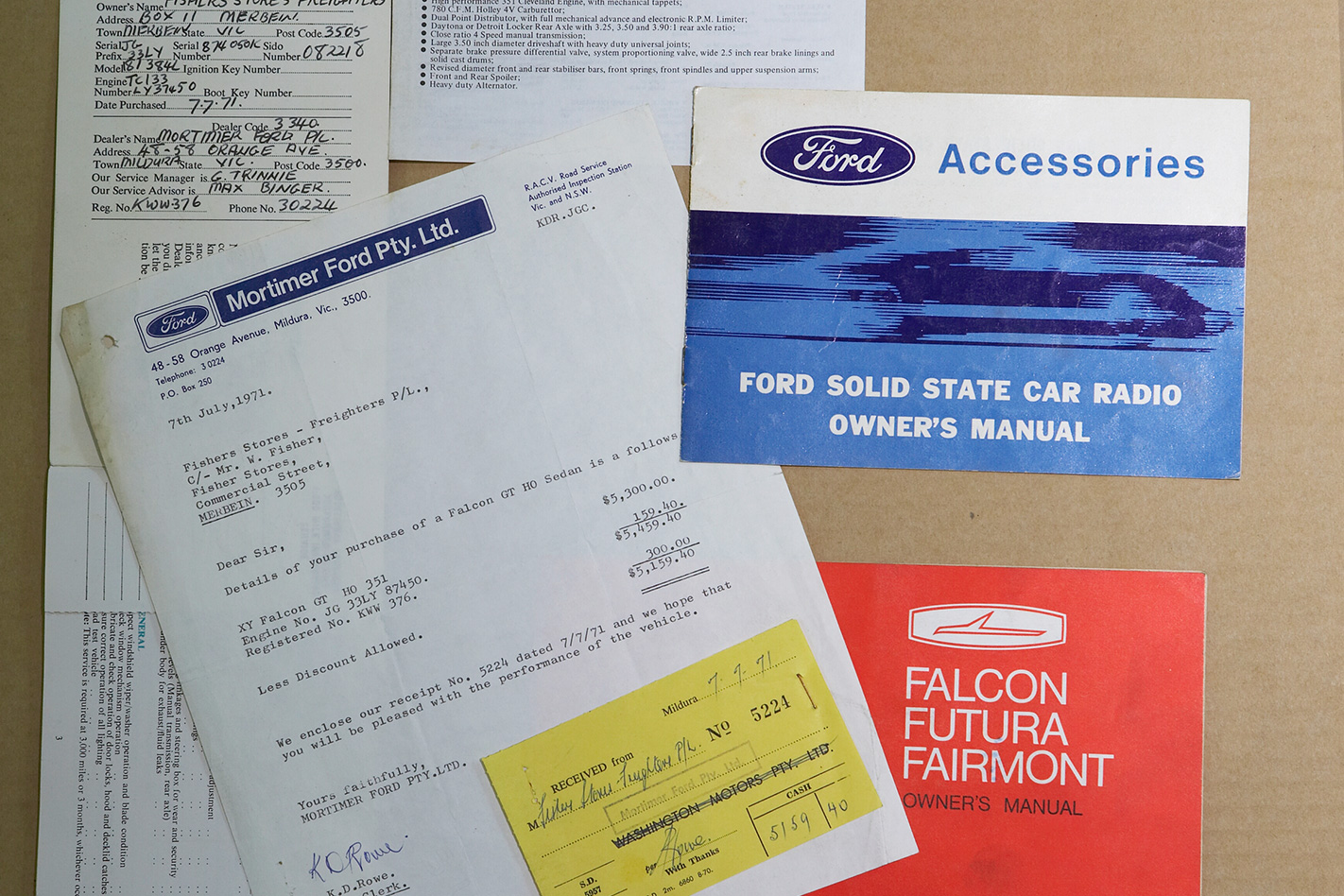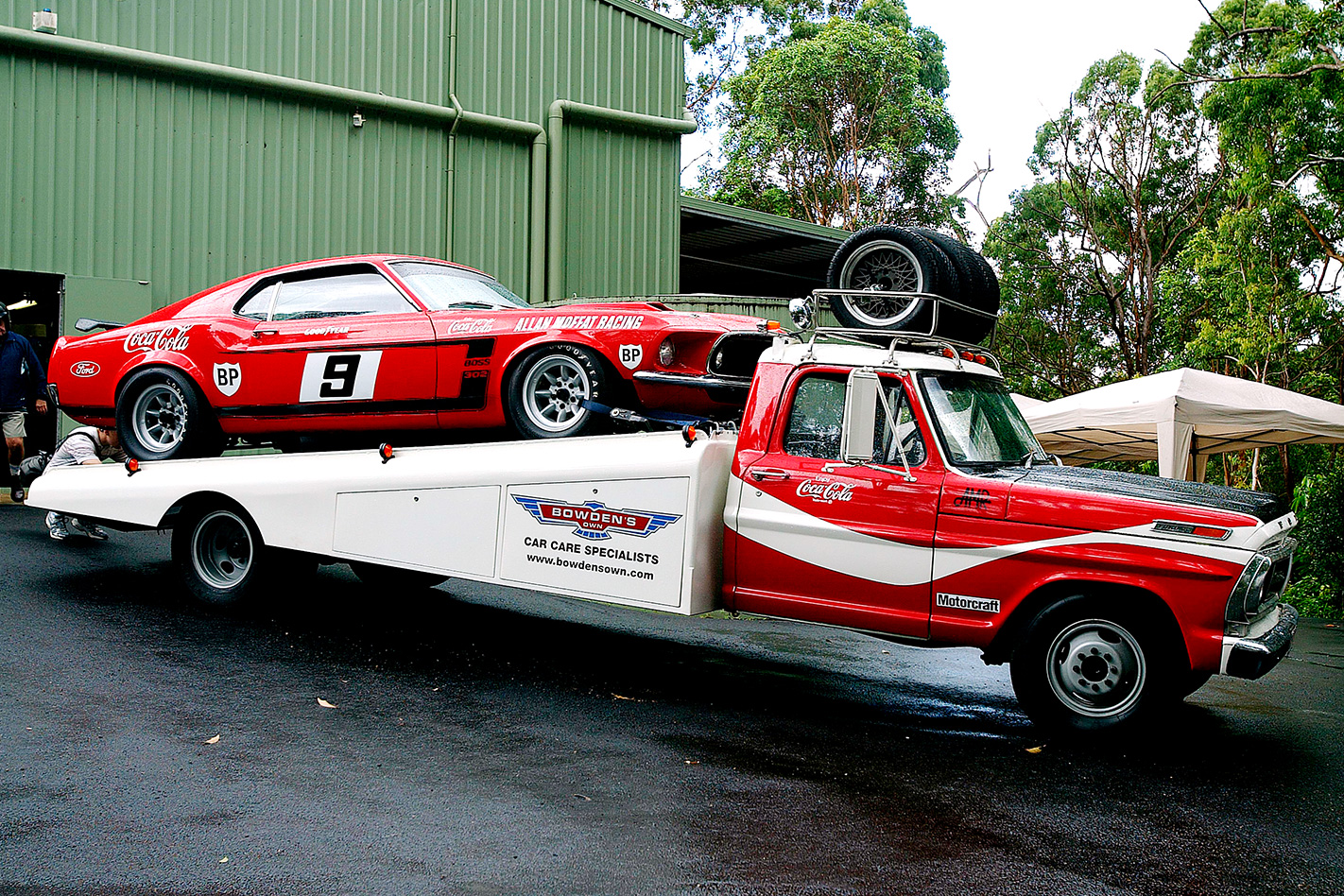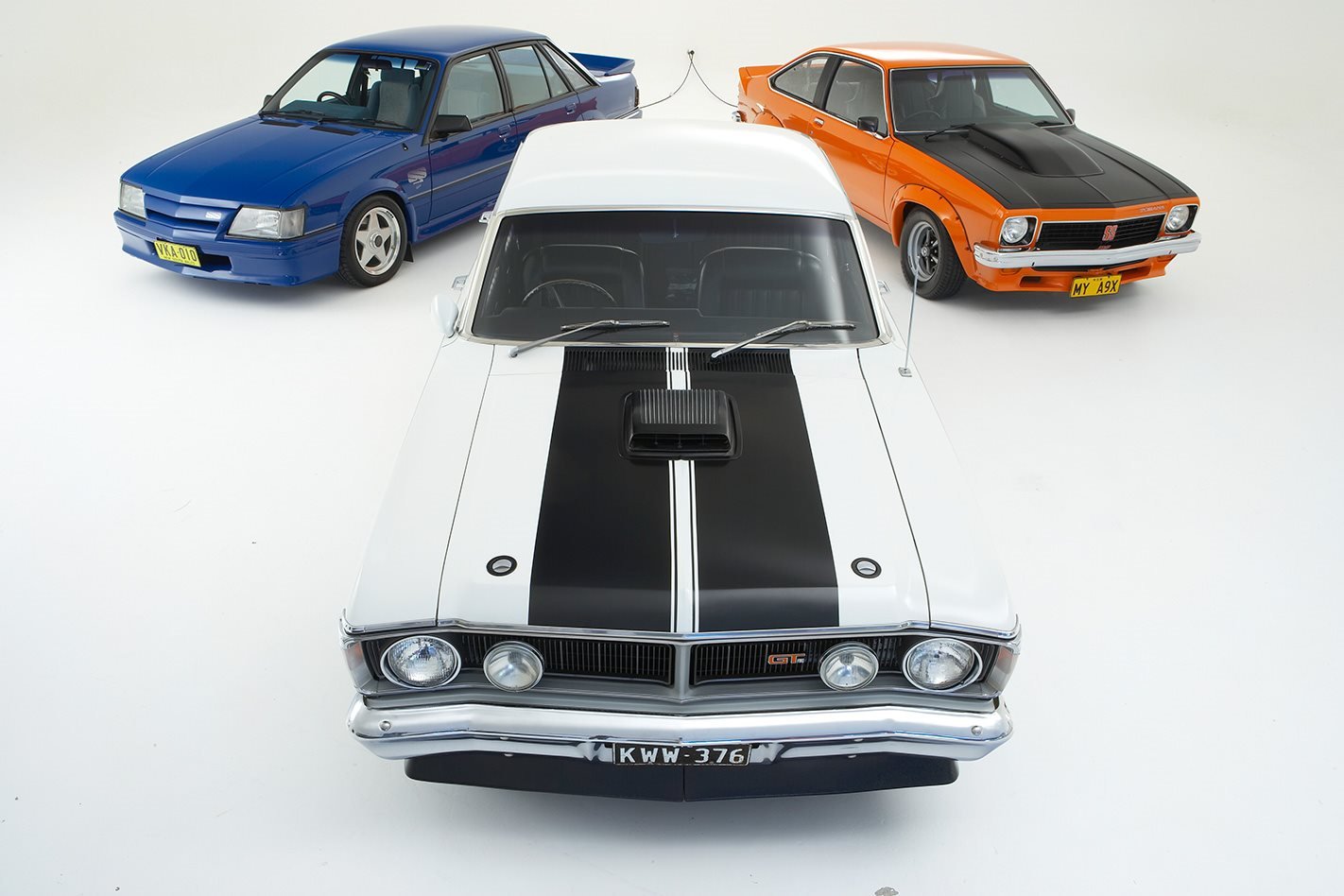If you were the speculating type, you might see the recent million-dollar-plus sale of a Falcon GT-HO at auction as a sign that classic Australian automobiles are ramping up in value in a big way.

However before you go hunting through barns to help expedite your retirement, it’s worth remembering that just a decade ago the prices for Aussie classics boomed bigtime – before hitting the brakes only a few years later.
Aussie Gold was first published in the June 2007 edition of Wheels magazine
THE GOLDEN age of Australian muscle cars began on 18 April 1967, when Ford Australia unexpectedly announced to its dealers a high-performance version of the XR Falcon.
The ‘Mustang-bred’ XR GT was in direct defiance of Ford Motor Company’s order to stay out of motorsport, and ended the delicate dance of diplomacy over what mattered most among Australia’s Big Three: an annual, 500-mile race in a country town called Bathurst.
The XR GT unleashed a fraught five years of home-grown hero cars: Holden’s 327 and 350 Monaros taking the fight to ever-more powerful Falcon GTs, with Chrysler’s swift, six-cylinder Hemi-engined Valiant Pacers and Chargers always lurking nearby. And road owners never had it so good, thank again to the Hardie-Ferodo 500’s homologation requirement that a minimum of 200 examples be built.

It was also an era that ended suddenly, controversially, with a transport minister’s self-promoting media campaign that went into history as the ‘supercar scare’. But perhaps the real golden age of Aussie muscle cars began almost exactly 40 years later, on 25 March 2007 in an auction room in Melbourne. A 1971 Ford Falcon GT-HO Phase Ill, one of 300 built and some 90 remaining, was knocked down for $605,000 – or more correctly, $683,650, including the auctioneer’s fees.
For months, there had been rumours of private-sale offers of more than half a million dollars for top XY GT-HOs. But here, at last, was the evidence that Australian muscle cars had attained international collector-car price levels, outstripping even America’s muscle-car icons. Many Chargers, Falcons, Monaros and Toranas, already fetching six-figure sums, had probably doubled in value overnight.
“It was a landmark auction, in a way,” says Robert Glover, the youthful and very satisfied head of collector cars at auction house Bonhams and Goodman. “In front of everyone, this is what it sold for [so] that is now the benchmark. No-one is going to give away a real GT-HO for less than $400,000.”
The price was even more remarkable because this car, in collector terms, was the opposite. The red, May 1971-built example had reportedly been bought by the previous owner eight years earlier, for $100,000. He had restored it beautifully, but the car lacked books to verify its 25,000-mile odo, or explain much of its ownership history.

What it did have was Allan Moffat’s autograph on its glovebox lid. This, along with factory-spec peculiarities like the 36-gallon fuel tank and the omission of Super Roo decals, led to (hastily retracted) claims of it having been Moffat’s personal or company car.
“I know nothing about the car whatsoever,” Moffat says, explaining that he never had a GT-HO road car. Indeed, the HO was too valuable (and in demand by dealers) to be handed out as a company car. Moffat chuckles: “In 1969, when the [Phase I] HO was launched, they were $4500. And the regular Falcon was $2500. And I said to the director of marketing at the time, ‘Man, who’s going to pay $4500 for a Falcon?’ And he said, ‘You’ll be surprised, Allan …’
“Unfortunately, I wasn’t surprised enough to go out and purchase one. Or a dozen.”
Moffat might otherwise now be sitting on as many millions, according to auctioneer Glover. “I think, now, that if someone phoned me up and had a GT-HO with, say, 4000 miles on the clock, and all its books, I probably wouldn’t be willing to reserve it at a million bucks – but I wouldn’t discount it being able to make that. Because people will pay a huge amount more to get the best.”
Darryl Mattingley is satisfied that he has. The 56-year-old owner of a house-removal business in Emerald, Queensland, has an eclectic collection of about 20 Australian road cars, which includes several original, low-mileage early Falcons. But in the past 12 months he’s also added the very first and last of the V Series Monaros, which collectively cost somewhere between $300-$400,000. But his Holy Grail, he says, is the car he bought on 25 March.

“I just like collecting,” Mattingley says. “I don’t know how to explain it, because I’ve got a $700,000 Phase Ill GT-HO and I’ve got two Monaros that are brand new. And I’ve got a Mini Moke and a Mini Minor.”
In the wake of his Phase Ill purchase, Mattingley was painted by some media as the idle, irresponsible rich. “It couldn ‘t be further from the truth,” he says. “Mate, I work very hard for every penny I get, and people have got the idea that I had $700,000 sitting in the bank waiting to buy it. I didn’t.
“A soon as I bought it, I raced down to the bank manager and said,’Now, listen, I need some money in a hurry.’ But I’m lucky to have that, to have some real estate backing to be able to do it.”

So who is buying the great muscle cars of Australia? According to Christophe Boribon, national auctions manager for rival house Shannons, these are a different mob from those that drove the prices of Jaguar, Alfa Romeo, MG and other attainable exotics briefly through the roof in the late 1980s.
“What we’re seeing today is a totally different breed of people, blue-collar guys,” Boribon says. “Generally, the people who’ve bought these cars from us in the past two years have been from the age of 45 up to about 60. They’re not lawyers, doctors, solicitors – they’ re people who’ve done very well in business, but have come from a very humble background.
“They’re pulling the ir money into the cars they grew up with,” Boribon continues. “They’re the cars they went out to Sandown and Bathurst to watch race. They can relate to those cars.”
The effect of supply and demand is illustrated by combining a precarious quantity of cars and the largest, richest and most self-indulgent generation in global history: the post-war ‘baby boomers’.
This generation, generally classified as those born between 1946 and 1964, are a phenomenon of historical timing. They grew up in a world largely free of major wars, of almost unrelenting economic growth – they were far enough up the tree to weather both recessions – while antibiotics, immunisation and surgical breakthroughs have coddled them since childhood to a predicted life expectancy of 85 years.
“I guess the worst hardship was having to selI the BMW in the crash of ’87,” says David Chalke, social analyst and director of market research service AustraliaSCAN. That’s right: remember the yuppies of the late-1980s? Baby boomers, when they were younger.
“There’s a bout five million of us we represent about a quarter of the population of Australia, but we control about half the wealth,” Chalke says.
“The boomers are largely still working- even the first of the boomers are only now 62. Their asset base is huge, and growing exponentially, because the nest is emptied, the mortgage has been cleared, they’re stashing away investment money like crazy and have got a large discretionary income at the same time.

“Classically, when you go through that phase, you go through a complete rejuvenation of life. So they’re rejuvenating themselves – gym memberships, botox, all that sort of thing- and rejuvenating the home.
They’re the biggest-spending group on top-end kitchen renovations, the $50-$60K jobs …
“They now have the time to engage, or in many instances re-engage, in the passions of their youth. They have the money, the technology, the ability to do the things that really fired them up as kids. And so, in the instance you mentioned, he was a Ford GT-HO fan, always wanted one – ‘I’ve got the dough, it’ll be an investment, I can sell it in 10 years and a t least get my money back … ‘ It’s so common.”
Auctioneer Roben Glover agrees. ” It’s a lifecycle with cars. You’re probably going to see something similar with Ferrari F40s in 10 or 15 years’ time, because those are the cars that people of my age had as posters on the wall [as kids]. When these guys are in their 50s, a lot of them have a lot of money, so you get this situation where there’s this huge demand from people who have got a lot of money.”
Yeah, but in 30 years’ time, the baby boomers will be dead. What then for a $700,000 investment that means little to a younger generation of Australians?
“Classics will forever be classics,” David Chalke responds. “You’re right in that they won’t have the emotional connection back to your youth – it will have lost some of its allure – but they’ll be rarer then, and there will still be collectors.”
Darryl Mattingley and his wife Shelly bought the Phase III with their eyes wide open. ” l just think, and hope, it will be worth a million dollars, this thing,’ Darryl says. “And my wife has worked it out : with the interest repayments, it’s got to go up X-amount of dollars each year or we’ re going backwards. While it’s a passion, it’s also an investment.”

Books or not, he knows what he’s got. ” I’ve got the SIDO number, l’ve got the Ford printout which tells me exactly what that car had,” he says. ‘And that car is exactly as it drove off the showroom floor. It tells me it had seatbelts, a 36-gallon tank, eight-track player which it’s still got, left-hand mirror, which it’s still got. .. lt was delivered to Ford Motor Company itself, and it was ordered minus stripes.” Just as interesting, perhaps, were the whereabouts of a young D Mattingley at the time.
“I did my apprenticeship as a Ford mechanic at the garage here in Emerald, working on those cars,” he says, without hesitation. “There were two HOs sold in the Ford dealership here. And yes, I know where both of them are! I wanted to buy one of them because I worked on it, but he wouldn’t sell it to me. But since I bought this red one, now he wants to sell it to me.”
The apprentice’s tale has a parallel in David Bowden, the former touring car race wrench, turned financial high-flyer who, in the past two decades, has acquired many of Australia’s most significant racing tin-tops. While Mattingley acknowledges that their passions differ- ” he collects race cars, special cars, in their racing condition”- Bowden figures road cars will always be slower than racing cars.
“Most of the car collectors with the HOs are reasonably smart because they’re paying that sort of money,” Bowden says. “That bloke that paid $600K, he’s pretty smart, he’s an accountant. I’ve never met him but he wouldn’t be a dill- but one thing they’ve still yet to learn is provenance.”
In the mid-1980s, Bowden says, after a tax wrinkle cleared out all but the (then-dismantled) 1970 Pete Geoghegan Super Falcon from his collection, he “decided to stick to cars with race history. I knew that somewhere along the line, they were going to be a good investment … And yet, we had top competition cars selling for the same price as regular road cars.

“You see a [Jaguar] D-Type that’s won Le Mans, compared to a normal D-Type, and it’s [the Le Mans car] worth three times as much. With Bathurst and that, we’re going to see the day when these cars are probably triple what they’re worth now. The road ones won’t go anywhere near that far.”
Bowden’s collection includes, among its 80-plus cars, both of Peter Brock’s 1978 and 1979 Bathurst-winning Torana A9Xs and his 1972 XU-1. On GT-HOs alone, Bowden has ex-Moffat Phases I, ll and III, and one of only three surviving Phase IVs.
Of his collecting, Bowden simply says: “It was two things: I had the dough to do it and it was fun. If you fell over a lot of money at some time, you’d probably do the same thing. But the other thing I realised, I just knew we had to get these good car back here. To not have the Mustang in Australia was just criminal.”
Ah, the car that launched a thousand night emissions among adolescent baby-boomers: Moffat’s 1969 Coca-Cola Mustang Trans Am. It is one of only seven Trans Ams built in ’69 (from 19 ever built), unquestionably the most original, and boasts a record of 101 race wins from 1970-’73, uniquely in Moffat’s hands. “It was the only one-owner Trans Am in the world,” says Bowden, who shipped it back from the US in 1995.
Had this internationally significant racing car, backed with sheafs of impeccable paperwork personally handed over by its champion owner-driver, cost less than $683,650 in relative terms? “Oh, yeah- in any terms,” Bowden chirps. “We weren’t talking anywhere near that amount.”
Perhaps unsurprisingly, Bowden feels that road-going Aussie muscle cars are already “well-extended”. Even the auctioneers acknowledge that, while the days of barn-finds and unwitting widows are very likely over, today’s stratospheric prices may not last forever.

Mattingley told Wheels: “Don’t promote me as a dill, please.” Hard to see that he is when, every day, people plonk down not-so-distant sums with unquestioning acceptance that their new car will dump 20 percent when it hits the footpath, and close to 50 percent in five years’ time. Mattingley’s GT-HO, at least, is running much shorter odds.
There are at least two other people in Australia willing to pay $600K for the right GT-HO; the auction had been a three-horse race. That’s great while there are rich people in Australia, but unlike a classic Bugatti or Bentley, these cars’ appeal are geographically limited.
Shannons’ Christophe Boribon: “You’re right, it is a small market. Where it’s going to end up, we just don’t know. Has it only got a couple of years in it, five years, 10 years? I really don’t know.
“l think it would be interesting to know what would happen tomorrow if we go into a recession. I do think a lot of these muscle cars will come back slightly in value. Five years ago, a Phase III Falcon GT-HO was worth $50-$80,000 – today the same car is worth half a million dollars. If a recession comes into play, I would say the cars will come back to $250-$300,000.”

Bonhams and Goodman’s Hobert Glover is more upbeat about the situation. “You’d never sell that Falcon in England, but in the United States there is potential, in the sense that they like cars of a similar ilk. To think if you did get one of the big American collectors who suddenly thinks it’s a good investment, all the other Americans will be, ‘Ooh, what’s he onto?’
“Besides,” Glover continues, “I don’t think it has got as ridiculous as it was in the late-1980s. When you look at what a house is worth, and the fact that E-Type Jags were selling for [GBP] 100,000, I don’t think it’s as mad now. People have been waiting for the crash – I know people in England who sold their houses five years ago – but it’s just continued going up and up.
“I can’t see any reason why it’s all going to go tits-up at the moment.”





